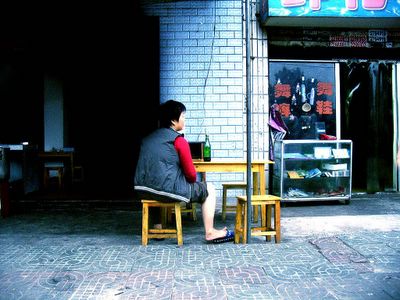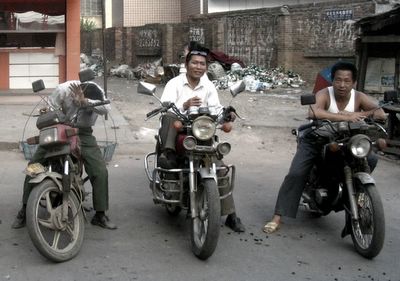 Huaihua - west - main street - BaoZi (Chinese Steamed Buns)
Huaihua - west - main street - BaoZi (Chinese Steamed Buns)
vendor - there are two types of steamed bread in China:
Northern-style and Southern-style. They are made from a
leavened dough based on wheat flour. Northern-style steamed
bread is produced according to a recipe containing only flour,
water and yeast, whereas Southern-style steamed bread contains
many other ingredients depending on the region where it is produced.
Traditionally, steamed bread has been prepared at home, but more
and more is now being made in factories or sold like here on the
street by vendorsphoto. mhobbs
 Huaihua - West - marjong - club - with Maosmiling perpetually down upon the playersphoto. mhobbs
Huaihua - West - marjong - club - with Maosmiling perpetually down upon the playersphoto. mhobbs
 Huaihua - western campus - "bean drying"photo/digital manipulation. mhobbs
Huaihua - western campus - "bean drying"photo/digital manipulation. mhobbs
 Huaihua - "Number 2 railway school" - middle school
Huaihua - "Number 2 railway school" - middle school
entrance - the tiled sign suggests to the students to -
"work hard and study more"photo. mhobbs
 Huaihua - Yingfeng East Road (central) - chicken washingphoto. mhobbs
Huaihua - Yingfeng East Road (central) - chicken washingphoto. mhobbs
 Huaihua - East - Yingfeng East Road -
Huaihua - East - Yingfeng East Road -
drain repair - husband and wife "team"photo. mhobbs
 Huaihua - East - Yingfeng East Road - truck repair -
Huaihua - East - Yingfeng East Road - truck repair -
on the "sidewalk" Late afternoon five men repair a truck photo. mhobbs
 Huaihua - University - western campus - Lah - mien restaurant
Huaihua - University - western campus - Lah - mien restaurant
owner - (Muslim wheat noodles restaurant) -
The Chinese have been feasting on noodles for at
least 5,000 years, since the Han dynasty. In fact, Italians
got their first taste of pasta when Marco Polo returned home
from his long trek across China with a host of exotic food items,
including noodles. The Lah-mien noodles are wheat noodles -
(Originallly from the north-west of China) In China, making
"hand-pulled" whaet noodles noodles is an art involving
holding the stretched out paste in both hands and whirling
it around several times. Then the paste is laid out on a board
and folded and refolded repeatedly. (the same as kneading bread)
Eventually the paste is transformed into long, thin, noodles.
In Huaihua it is still possible to watch vendors make
hand-pulled noodles. This man and his extended family have
travelled far from somewhere near the boarder of China
and Kazakhstan to recently open this restaurant.photo. mhobbs
 Huaihua - East Yingfeng East Road - woman listening to radio - late afternoonphoto. mhobbs
Huaihua - East Yingfeng East Road - woman listening to radio - late afternoonphoto. mhobbs
 Huaihua - East Yingfeng East Road - "stall holder" photo. mhobbs
Huaihua - East Yingfeng East Road - "stall holder" photo. mhobbs
 Huaihua - East Yingfeng East Road - Yang family traditional
Huaihua - East Yingfeng East Road - Yang family traditional
steamed "pot rice". The rice is cooked as normal in water
then drained and placed with assorted vegtables in the
"clay-pots" and cooked "dry" over hot coals for several minutes. photo. mhobbs
 Huaihua - East Yingfeng East Road - Yang family traditional
Huaihua - East Yingfeng East Road - Yang family traditional
steamed "pot rice" restaurant - preparing the seaweed soupphoto. mhobbs
 Huaihua - East Yingfeng East Road - Yang family traditional
Huaihua - East Yingfeng East Road - Yang family traditional
steamed "pot rice" restaurantphoto. mhobbs
 Huaihua University - eastern campus - "umbrella-girls"photo. mhobbs
Huaihua University - eastern campus - "umbrella-girls"photo. mhobbs
 Huaihua - University - western campus - view from
Huaihua - University - western campus - view from
the dinning hallphoto. mhobbs
 Huaihua - walking to Yingfeng Park - "Mid Autumn Festival"
Huaihua - walking to Yingfeng Park - "Mid Autumn Festival"
or "Moon Cake Festival" - a time for Chinese families to
come together - Mid-Autumn Festival is a festival to
celebrate the harvest for the year. After a full year of
hard labor, the farmers celebrate after the harvest
is done. Celebrated annually on the first full moon
of the 9th monthphoto. mhobbs
 Huaihua - East Yingfeng East Road - "farmer" photo. mhobbs
Huaihua - East Yingfeng East Road - "farmer" photo. mhobbs
 Huaihua - central - afternoon streetphoto. mhobbs
Huaihua - central - afternoon streetphoto. mhobbs
 Huaihua - central - cell phone user
Huaihua - central - cell phone user
- man squatting in shade - "thumbs" his phonephoto. mhobbs
 Huaihua - central - construction site - concrete pouring -
Huaihua - central - construction site - concrete pouring -
During 2004 China used (imported most) - over one quarter
of all the worlds concrete - this alone create's some of
the worlds highest readings of greenhouse gas emissions
and raises the ground and air temperature throughout the
ever expanding eastern Chinese cities and megapolises' -photo. mhobbs
 Huaihua - east - Yingfeng East Road - Night marketphoto. mhobbs
Huaihua - east - Yingfeng East Road - Night marketphoto. mhobbs
 Huaihua - eastern campus - polished marble stairs -
Huaihua - eastern campus - polished marble stairs -
"new" english buildingphoto. mhobbs
 Huaihua - eastern campus - tower - silver polished metal
Huaihua - eastern campus - tower - silver polished metal
edifice on the roof of the "new" english building
- shines in the morning sunphoto. mhobbs
 Huaihua - University - western campus - cafeteria - after the
Huaihua - University - western campus - cafeteria - after the
lunchtime rush - one of the many "cooks" takes a napphoto. mhobbs
 Huaihua - view of iron and "clay" roofs -
Huaihua - view of iron and "clay" roofs -
a flat rectangular piece of clay is formed to the desired shape
and size, (flat and long) it is placed on a wooden mold which has
been covered with a moistened cloth. the clay is placed on
a mold, it is then tamped into shape. The mold is then mounted
on a wheel, so that the clay can be smoothed quickly to a
uniform shape and size. (cylindrical) The wooden frame is taken
out, and the cylinders of clay are left to air dry.
After the clay has dried, it is broken into four segments.
These are then fired in a kiln. This same method has been
used throughout China since the Ming Dynasty (1368 - 1644 AD)photo. mhobbs
 Huaihua - University - eastern campus - "windows"photo. mhobbs
Huaihua - University - eastern campus - "windows"photo. mhobbs
 Huaihua - University - eastern campus
Huaihua - University - eastern campus
- caretakers home on foggy morningphoto. mhobbs
 Huaihua - University - western campus - Gate
Huaihua - University - western campus - Gate
- "welcome balloons" and banners for the new first year studentsphoto. mhobbs
 Huaihua - University - western campus - thermos stall - at the
Huaihua - University - western campus - thermos stall - at the
begining of each school year - thermos - wash basins -
coat hangers - bowls - lunch "cans" and plastic drinking-cups
are sold (at a profit to the University) to the new studentsphoto. mhobbs
 Huaihua - University - eastern campus - girls walking to classphoto. mhobbs
Huaihua - University - eastern campus - girls walking to classphoto. mhobbs
 Huaihua - east - Yingfeng East Road - woman on bikephoto. mhobbs
Huaihua - east - Yingfeng East Road - woman on bikephoto. mhobbs
 Huaihua - east - Yingfeng East Road - riders - bright
Huaihua - east - Yingfeng East Road - riders - bright
mid-afternoonphoto. mhobbs
 Huaihua - sidewalk - paper recyclingphoto. mhobbs
Huaihua - sidewalk - paper recyclingphoto. mhobbs
 Huaihua - sidewalk - wok washingphoto. mhobbs
Huaihua - sidewalk - wok washingphoto. mhobbs
 Huaihua - on the outskirts of town - construction - cranes and
Huaihua - on the outskirts of town - construction - cranes and
building sites litter the landscape - hordings proclaiming a
new standard in luxury - distract the eye - luxury apartments
and business park developments - are just part of the
endless development overtaking both the rural and
urban neighborhoods - This type of development posses
many questions about affluence and "for whom are they
building these for?"photo. mhobbs
 Huaihua - Yingfeng East Road - pulling a cart loaded with
Huaihua - Yingfeng East Road - pulling a cart loaded with
refuse from one of the many restaurant that line Huaihua's
main streetphoto. mhobbs
 Huaihua - University - eastern campus - English major studentphoto. mhobbs
Huaihua - University - eastern campus - English major studentphoto. mhobbs
 Huaihua - University - western campus - early morning -
Huaihua - University - western campus - early morning -
teacher walks to catch the bus to the eastern campus -
a ten minute jouneyphoto. mhobbs
 Huaihua - central market - woman preparring coals to
Huaihua - central market - woman preparring coals to
"dry-roast" chestnut'sphoto. mhobbs
 Huaihua - eastern campus - english building -
Huaihua - eastern campus - english building -
security guardphoto. mhobbs
 Huaihua University - western campus - bikephoto. mhobbs
Huaihua University - western campus - bikephoto. mhobbs
 Huaihua - University - eastern campus - English major
Huaihua - University - eastern campus - English major
student - with class sizes close to fifty and almost
three in four students not obtaining a place at any University
within China - this young woman - a second year
English major - is one of the "lucky" onesphoto. mhobbs
 Huaihua - University - eastern campus - windows of the "new"
Huaihua - University - eastern campus - windows of the "new"
teaching buildingphoto. mhobbs
 Huaihua - central - small "back street" - motor bike menphoto. mhobbs
Huaihua - central - small "back street" - motor bike menphoto. mhobbs
 Huaihua - eastern campus - stool "stack" - students piled their stools
Huaihua - eastern campus - stool "stack" - students piled their stools
in this chaotic fashion - at the entrance forecourt of the new
english building - waiting for a "Chinese" english teacherphoto. mhobbs
 Huaihua - eastern campus - new english building "tower"photo. mhobbs
Huaihua - eastern campus - new english building "tower"photo. mhobbs

















































